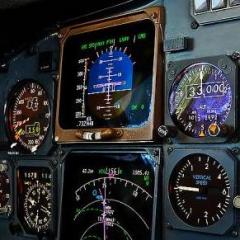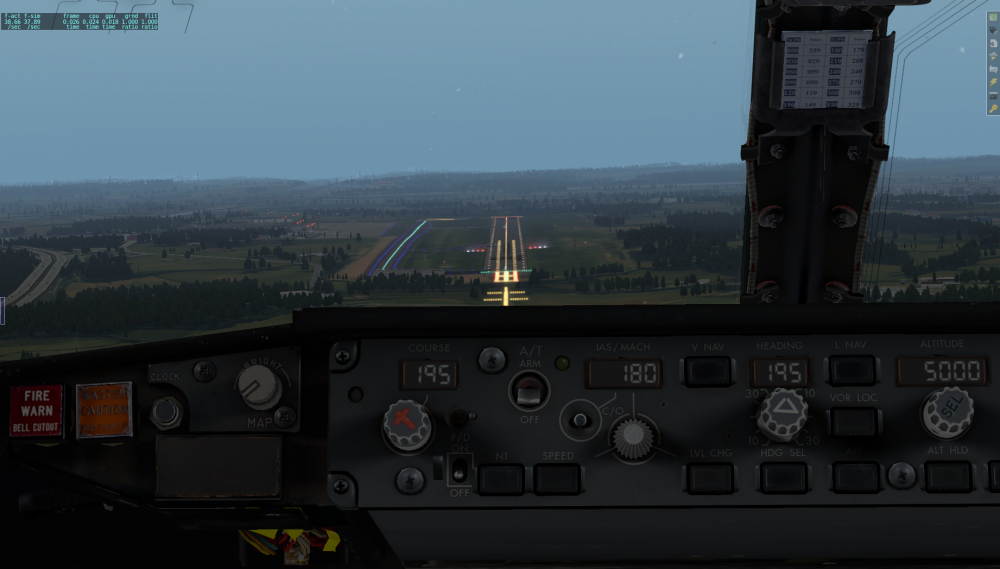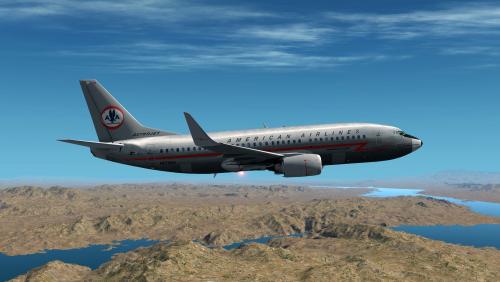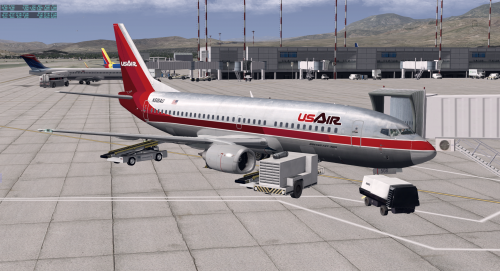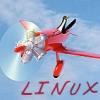Leaderboard
Popular Content
Showing content with the highest reputation on 05/10/2016 in all areas
-
As many of you know there are plenty of things to remember and many of ways to operate in the real world. I will pass on some of the tips I use real world that should help in the sim world also. One of the biggest concerns when flying passengers is passenger comfort. It's even more important in the corporate world that I operate in. From time to time I find myself riding as a passenger when attending recurrent sims and when picking up/dropping off aircraft. One of the most noticeable things when riding as a passenger is sudden or aggressive pitch changes. This happens for various reasons, but here are some tips to minimize the occurrences. When initiating climbs, it's a good idea to start in vertical speed. Select vert speed and smoothly dial it up until the engines reach max power. Once there, select FLCH and the passengers will not notice at all. If you select FLCH first, the engines will surge forward, and then the nose will pitch quickly to maintain the current speed. The Gulfstreams I fly have the ability to decide the amount of thrust to use based on altitude changes 6,000ft or less, but it still can get aggressive. Some guys like to set 200 to 300 feet per minute in the first few seconds and last few seconds of the altitude change. I prefer a smooth increase instead of wasting free brain cells milking the vert wheel. In the real world, FLCH gets pitchy after mach change over, but no worries in the sim. When using FLCH when climbing above change over, I watch it like a hawk. As soon as the plane starts a move, I hit the vert speed button to lock it in. Once the airspeed settles/recovers, I max out the engines and re-engage FLCH. This happens because of temperature inversions and wind changes as you climb. This can easily cause a instantaneous change on the speed indicator causing the plane to quickly pitch to adjust. If you are paying attention, you will see the speed change and hit vert speed before it pitches. When the jet is heavy, it lags a little and makes FLCH less pitchy. Another good tip is to use vert speed when light weight if you are clear of obstacles. 2000fpm works well. This technique slows things down and makes the jet more manageable. If you are climbing at 4000 to 5000fpm, the jet will make an aggressive zero g maneuver at level off. It's much easier to use vert speed in this case. When I would return back to base after training missions back when I flew KC-10s, we would do about an hour of transition and pattern work. We would get back at about 380,000 pounds compared to the max 590,000 pounds. Newbies would perform an autopilot go around up to 2000ft. At 380K and 3 engines churning out 52,500 pounds of thrust each, 2000ft comes very fast. The look on their faces when the plane would aggressively pitch to capture and every now and then blow past the altitude, was priceless. I taught them that after you hit TOGA and the plane gets going, you needed to quickly vert speed and back it off. If you hit vert speed too late, you would ruin the capture mode and blow past the altitude for sure. Those were some fun times. Another good tip is speed brake use. I hear plenty sim experts shade people for speed brake use and I think it's rubbish. They were put on the plane for a reason. I also spend a lot of time operating on the NE coast of the USA and we get slam dunked into airports all the time. They keep you up longer and only step you down a few thousand feet at a time. There isn't a descend VIA, it's only constant crossing restrictions on the way down. I hardly ever get to use VNAV on descents. What you find is that you have to use speed brakes and use them early! Even in the real world i see people get so far behind and rushed because they were taught not to use the brakes. It's quite common to ride the brakes on the river visual to 19 at KDCA. There are two tricks to speed brake use. 1. The earlier you use them, the less amount you will need. SA is everything. 2. Speed brake use is like slipping out and back into bed with your significant other sleeping. You ease them out nice and slowly. Once you are done, you ease them in slowly. In some cases, you have to ride the brakes until you are ready to trade them for flaps. You work in flaps, and then ease in the brakes. I'm sure if you could descend when ever you want, you wouldn't need them, but welcome to the real world. When operating in areas with close multiple airports with departure and arrival corridors, it gets interesting. I like the 3 or 4 times your altitude to lose technique. So if i have 10,000ft to lose to be at 2000ft 10 miles from the airport: 3 X 10 = start descent by 30 miles from the field. 4 times your altitude to lose works well also because it gives you more time to slow prior to 10,000ft. If you are at or past this point and have yet to descend, you will need some brakes. Guys will say that the brakes are loud and rumble, I guess they have never sat aft of the wings on an airliner. For slowing, I like 12 at 12 or 13 at 13. Basically set 1300 fpm at 13,000ft to reach 250kts by 10,000ft. This has worked very well in all the jets I've flown. In most jets, you can only get 1500fpm and maintain 250kts clean. Any higher rate, and you will accelerate. Just in case you didn't catch my 737 techniques in another post, I'll post them again. Keep in mind that these are more aimed at the BBJ, but should work. Aircraft References • Main Gear on your side: NESA Transmitter in lower outboard of window • Main Gear on Opposite side: Lower inboard corner of window • Outboard Side of Engine on your side: Window Handle • Outboard Side of Engine on Opposite side: Glare Shield bend • Wingtip on your side: 2.5 concrete blocks • Nose Gear: Inside of HSI Engine Start (Approximate values) • 2 -- 20% N1 • 4 -- 400 degrees EGT • 6 -- 60% N2 • 6 -- 600 pph FF Before Takeoff (LLLAASSTT Chance) • L-anding Lights (tech: nose wheel light on when cleared for takeoff) • L-adies (sit the FAs down with PA message to the back) • L-ower DU display cleared • A-utothrottle ARM (tech: when cleared for takeoff) • A-utobrakes - RTO • S-trobe lights ON • T-errain (tech: Captain Terrain/FO Weather) • T-CAS (TA/RA) 10,000’ check during climb out (FLAAPS) • F-uel Pumps (Ctr Tank management per alternate operating procedures) • L-anding Lights -- RETRACTED/OFF (consider 18,000’ in high-traffic areas) • A-irspeed -- accelerate to desired climb speed • A-PU -- Off/as desired for shorter flights/EROPS/WX • P-ressurization check (Auto/pressurizing/cabin alt OK) • S-eatbelt (double ding by going off/wait 1 sec/on then auto) Before Descent (AIRBAG) • A-TIS • I-nstall the Approach • R-adio’s -- Tune and ID • B-rief the Approach • A-pproach Checklist • G-o Around Procedures (How will the airplane fly it? HDG SEL, etc.) Planned Descent Point • Timing -- Approx. 10 seconds for every 100’ of altitude to lose • Distance -- Divide HAT by 300’. This is the distance to start descent from the end of the runway. Enroute Descent Path Planning • Build a waypoint 40 NM track distance from the landing runway with 240/10000 inserted for Speed/Altitude. - AND/OR - Use the fix page and put a 40 NM circle around the runway (or FAF) and plan to cross the circle at 240/10000 for a straight-in arrival. • When planning an enroute descent to radar vectors to final it can be difficult to determine how far out you will be vectored and how soon you should begin your descent. Request a descent at a distance that will allow a constant 1500 fpm descent. To determine this descent point: • Load the expected approach using the FMS DEP/ARR page • Load the FAF or OM point/altitude on the descent page at 3R. • You can monitor the V/S as you approach this point. When the V/S approaches 1500 request descent. Even if the descent is not granted immediately, you will have a very good target descent rate when ATC permits the descent. This technique provides a constant descent that mirrors our constant climb to cruise profile. Descent Profile • 3.5:1 (Miles : Altitude) • For every 50 Kts of wind +/- 2 Miles • Losing 10 KIAS Takes 1 NM 10,000’ check during descent (10,000’ AGL for higher field elevations) (FLAAPS) • F-uel Pumps (Ctr Tank management per alternate operating procedures) • L-anding Lights -- EXTENDED/ON (consider 18,000’ in high-traffic areas) • A-irspeed -- decelerate to 250 • A-PU -- On/as desired/WX considerations • P-ressurization -- set for landing field elevation • S-eatbelt (double ding by going on/off/wait 1 sec/on) Cat II/III ILS (ABCD) • A-PU -- On • B-rake Setting • C-at II/III ILS Procedures • A -- Approach Brief • A -- Alert/Decision height callouts • A -- Altimeter bugs (radio and barometric) • D-epart runway plan (How will you taxi to park -- SMGCS?) Before Every Approach • “AAABBCC” • A-TIS • A-pproach loaded in FMS • A-irspeed set in FMS • B-rief • B-rake setting (off, 1/2/3/Max) • C-hecklist • C-onfiguration (flap setting) • “CRAMPS” • C-ourses -- set/verify inbound course on MCP for FP & PM • R-adios -- set/verify correct frequency (ILS/VOR/Tacan/NDB) • A-ltimeters -- set/verify QNH/QFE as appropriate through transition • M-inimums -- set/verify for PF & PM • P-ush -- APP mode (or VOR/LOC or LNAV or Hdg Sel) • S-peeds -- set/verify Vref is set and displayed for flap setting Engine Failure on Takeoff • “4 Cs” (accomplished when flaps are up at min. maneuvering speed) • C-hange (Level Change) • C-ontinuous (Max Cont) • C-rossfeed (with fuel only in wing tanks) • C-hecklist (NNP then After Takeoff) Single Engine Trim • Trim into good engine is approximately equal to Fuel Flow Single Engine ILS Approach • At 1.5 Dots or later on the Glide Slope -- • Gear Down • Flaps 15 • Reduce Thrust 10% N1 Non-ILS Approach (VNAV is preferred for straight-in approaches) • 3 NM -- Configure (Gear Down/Flaps 15, Bug 15, Landing checklist to flaps) • 2 NM -- or sooner/Set Next Lower Altitude (ensure VNAV if using) • 1 NM -- Flaps 30, Bug 30, complete Landing checklist • 0.2 NM -- V/S As Desired (unless using VNAV) Touch and go/pattern work Missed Approach Note: Assumes intent for complete flap retraction to missed approach holding pattern. • TO/GA (A/P will kick off under single-channel operation) • Set Go-around thrust • Set pitch to Go-around attitude • “Flaps 15” • Positive climb rate - “Gear up” • 400’ AGL - “LNAV” or “HDG SEL” (Note: for Non-Precision approaches your probably already at/above 400’ AGL or very close if going missed from and DA/DDA/MDA) • Retract flaps on speed • 1000’ AGL - Set LVL/CHG or V/S + 1500’ • After Takeoff checklist (Ops Man) Radar Pattern Climb Out From Touch & Go • PF rotates aircraft to 15 degrees nose high • Positive climb rate - “Gear up” • Flight directors - ON (if coming from VFR Pattern OR Recycle) • 400’ AGL- “Bug Up, flaps 5, LNAV or HDG SEL ” • 1000’ AGL - Technique: "V/S, Set 1500 fpm" or "LVL CHG" • Retract flaps on schedule to “Flaps Up” • After Takeoff checklist • Maintain flaps Up for downwind Note: PF re-establishes A/P and manually arms Autothrottles • PM rechecks weather, installs approach and helps tune nav radios (technique) • PF briefs approach, tunes radios and calls for the “Approach check” Precision Approach (use “CRAMPS” check technique) • Arm APP if cleared approach on intercept heading • G/S alive - “Gear down, flaps 15, Bug 15, landing checklist to flaps" • G/S intercept - “Flaps 30/40 (final flap), Landing checklist” slow to VREF + additive Non-precision approach (non/VNAV) • Arm LNAV or use HDG SEL for lateral maneuvering • 3 miles prior - “Gear down, flaps 15, Bug 15, landing checklist to flaps” • 2 miles prior (or earlier) - Set MDA or stepdown altitude in altitude alert window • 1 mile prior - “Flaps 30/40 (final flap), complete Landing checklist” slow to Vref + additive Note: Do not arm speedbrakes or use autobrakes if accomplishing a touch & go. VFR Pattern Climb Out From Touch & Go • PF rotates aircraft to 15 degrees nose high • Positive climb - “Gear up” • Turn off FDs if not already off (technique) • 400’ AGL - “Bug 5, flaps 5” (technique) • 1000’ AGL - PF lowers nose to 10 degrees pitch and reduces thrust (at Bug 5 speed) to approximately 75% N1 (technique) • PF levels off aircraft at 1500’ AGL or pattern altitude and maintains flaps 5 on downwind VFR Pattern • Enter downwind at flaps 5, speed Vref 30 + 40 (Bug 5 speed) • VFR pattern briefing - "30/40 Flap touch and go, Speed is ____" • Approaching abeam touchdown point - “Gear down, flaps 15, bug 15 Landing checklist to flaps” slow to Bug 15 • Before turning or during turn to base - “Flaps 30/40, Bug 30/40 + ___ (additive), complete Landing checklist,” slow to Vref + additive • Descend as required (approximately 600-800 VSI as a guide) Note: Do not arm speedbrakes or use autobrakes if accomplishing a touch & go. Technique for Establishing Automation After Pattern Work Note: Technique used should be pre-briefed. Assumes the "gear up" and "flight director’s - ON " is already called/done. • 400’ AGL "Bug Up, Flaps 5; HDG SEL or LNAV" • 1000’ AGL (or A/R) "Vert Speed + 1500’, Flaps 1" or "Level Change" (Flaps 1 above F5 speed and then flaps on schedule) • PF establishes A/P by selecting CMD and A/Ts -- ARM NG techniques.pdf6 points
-
Taking a short break from heavy metal (read: IXEG) Linz, Austria [LOWL] to Portoroz, Slovenia [LJPZ]3 points
-
This week, i have no time to work properly about X Plane things. Some improvements to test in this file (jsnapp fixes are included). Fight of wheel trim is fixed. The 2 spots on the roof, behind the seats are now synchronized. Axes settings are send from master to slave (Recommended by Morten: 3 left cursors to 0, 3 right cursors to 25%, null zone to 10). @jsnapp. You are right.about weather. No joy with animation of the radios knobs (speed knob as well). Claude. smartcopilot.zip2 points
-
Thx for the report xplana. I am about to enter a phase of very dedicated FMS work and hopefully catch all of these items. I am having to take a week off due to family medical issues and in addition, I have a daughter graduating college/university this weekend. ....and I'm dealing with family most of the week. I am VERY anxious to jump onto the FMS in earnest and bring it to its potential...is is much closer than the gizmo soft crashes would indicate....I just need to fly a lot. Thx again for the reports. -tkyler2 points
-
I will do everything that helps you solving bugs :-) Will come back on that topic tonight. Sebastian2 points
-
2 points
-
2 points
-
2 points
-
2 points
-
2 points
-
It´s starting to wear on me that we only have 5 or 6 737s left at Lufthansa. Last flight is planned for something like October, and I really hope they will throw a farewell party, but for some reason I doubt it. I start taping and taking pictures of all the 737´s I see, my Copilots think I am crazy . Just yesterday I saw our newest model, D-ABEF! (Only a little over 20, still a youngster!). And what do we get to replace them? NEO´s... what a nightmare. Jan2 points
-
1 point
-
Hi, quick info for EFASS users: The Flightplan-Export plugin for the IXEG is ready. How to install: Start EFASS Click File -> Addon Downloader Double-Click the plugin "Export to IXEG 737" to download it Click away all those messages and restart EFASS Export-Path for flightplans: <X-Plane-Folder>\Aircraft\X-Aviation\IXEG 737 Classic\coroutes Loading the flightplan: Go to the RTE-Page of the FMC and enter the Departure-ICAO and the Destination-ICAO without space into the Co-Rte-Field. Example EDDLDTTA ALWAYS USE THE SAME AIRAC CYCLE FOR EFASS AND THE 737! ALSO THE SAME PUBLISHER (NAVIGRAPH/AEROSOFT). OTHERWISE YOU MAY GET A MESSAGE LIKE "AIRPORTS MISSING" Cheers, Cosmo1 point
-
1 point
-
IXEG B737-300 ANA Wings View File All NIppon Airways's fictional livery. Super Dolphin is for B737-500 (2.4m shorter than -300) Submitter obochi Submitted 05/07/2016 Category IXEG 737 Classic Livery For Click Here For Aircraft X-Plane Version(s)1 point
-
ANA Gold for IXEG 737-300 View File ANA's Gold Livery B737-300 for IXEG! Submitter nellhama Submitted 05/10/2016 Category IXEG 737 Classic Livery For Click Here For Aircraft X-Plane Version(s)1 point
-
Egypt Air for IXEG 737 Classic View File Based on the Boeing 737-500 livery of Egypt Air. The flags on the fuselage are a little offset from the real plane, as an anomaly on the right side fuselage causes the flag to distort. Small text might also be a little off, but this is however a fictional livery for your enjoyment. Thank you for your support. Submitter SpeedBirdNam Submitted 05/10/2016 Category IXEG 737 Classic Livery For Click Here For Aircraft X-Plane Version(s)1 point
-
1 point
-
Orth4XP does indeed create a new nesh and so all other meshes are disabled and can be removed from disk, in order to save space. HD mesh and UHD mesh, however, have some elements that Ortho4XP will not generate by default, like roads and autogen scenery; in order to recover those elements you must instruct Ortho4XP to sniff either default x-plane mesh or HD mesh, so, you should only remove the latter after having generated tho overlay for that area. José1 point
-
Well, I'd like to hear other peoples' opinions on this. Earlier today we heard from someone who actually wanted the weather to update more frequently - say every 10 minutes, in order to have the most up-to-the-minute conditions possible. If we only updated weather on new areas you're flying into, you might have to fly 100km or so before seeing the updated conditions around you. Seems like one of those things where you are going to make some customers unhappy no matter what. One thing SMP 3.2 will do is check to see if a newly dropped METAR file actually changed anything or not - and if not, it won't do anything with it.1 point
-
Do you use Control Pad (iPad app for x-plane) ? That's giving me stutters, but as said above there are more possiblities.1 point
-
I noticed you use a xsaitekpanels.ini version 2.51, but the plugin itself is version 2.50. Perhaps that's causing the crash. I use xsaitekpanels plugin soo far without crashes.1 point
-
Thanks for taking the time to do this comparison, Tom! I am not much of an "audio" guy - but there certainly is a difference. I am sure it is fine to replace sounds in your folder with other sound-samples that you like better. If the wind.wav from default airplane is something you prefer, go ahead and replace the custom sound we provide (make a backup of it first?). Does this help? Cheers, Jan1 point
-
The original wind noise was a default X-Plane one placed in by mistake if I remember right. The new wind noise is straight from a hi-def recorder placed in a 737 during flight. You'd prefer the non-realistic version over the real 737 recording then? I suppose you could perhaps swap the audio files around. I'm sure Nils will investigate any type of looping anomalies if present.1 point
-
IXEG 737 SAS livery View File SAS vintage livery "Birger Viking" for the IXEG 737 Submitter safeflight_ Submitted 05/10/2016 Category IXEG 737 Classic Livery For Click Here For Aircraft X-Plane Version(s)1 point
-
1) My understanding of the way you had the file (and how we tried to leave it) is that those important aspects of wind altitude, speed, direction, and sheer are indeed synced well using the [CONTINUED] section, so that the pilot flying is the one sending that data to the other about winds. Looking at the file again though I see I accidentally also included those lines in [SLOW] as well. (Not sure how smartcopilot handles the double inclusion of a dataref in multiple places. oops.) I have commented them out now in the attached .cfg file that I am calling version 1.2.1 (hope you don't mind). The remaining weather items though I do think should be in slow, like setting the cloud types and height and barometric pressure. Those don't change very often and if they do they cause redrawing in the sim, correct? 2) The issue with nav2 is that doesn't seem to be a way to have both the dataref for the clickspot/knob actions (sorry I am blanking on the correct 3d cockpit terminology lingo) synced and having the tuned radio frequency stay synced. If you try and sync the user interface actions to get sound, if the over eager first officer drags the knob to fast you might lose a click and then the frequency will be mismatched. Currently we have it as you left nav1 where you just sync the frequency using the X-plane built in nav1/2 dataref and that means the frequency is well synced, but the two pilots don't hear the sound or see the animation of the other pilot tuning the radio. This along with the ability to sync the guards for example on the battery, emergency lights, and manual gear extension (to name 3 examples) are places where the developers will probably need to help out the effort by providing the appropriate underlying datarefs. Once @tkyler and @Morten get a breather perhaps they can help us out. :-) The biggest remaining issues I see are as follows: A/ Especially in cruise, we still see (and hear) the elevator trim seeming to fight and conflict, which leads to a sort of continuous stuttering trimming occurring. Does not impact in flight experience though. (Perhaps my latest edits to fix my goofs, see item 1 above, and attach config file will help, I don't know, haven't had a chance yet to fly it again with @dr_nerdrage.) B/ The FMC presents a huge challenge to sync between the two planes because it is a system with memory. On at least one occasion we have for example it will declare something like "Drag Required" on one system but not on the other. 90+% of the time though it seems to be in sync. Mostly it seems by making sure we communicate and ensure the scratch pad stays clean and in sync we have no problems though in actual flying. Yay. Again @tkyler will be needed to help with making sure the FMC and autopilot modes always stay well synced. (Btw, hilarity will and did ensue on one flight where we accidentally tried to fly with one pilot using navigraph data and the other using aerosoft data. The two FMCs happily programmed totally different routes from start to finish. ha.) ***** For those not interested in these nitty gritty development details, the smartcopilot file here is in immensely great shape and this plane is an absolute joy to fly together with another person, so go out there and fly! I am really hoping we can create a "virtual airline" of sorts with a fleet of 733's (and dare we include a few 732's and 722's) for us collectively to smartcopilot around the world together! **** Cheers, Justin smartcopilot.cfg1 point
-
Hello again, Just disregard this one. I had inadvertently turned HDR to OFF. HDR must be on in order for the fluorescent lights to work. Regards, Kyrre Andersen1 point
-
Garuda Indonesia for IXEG 737 Classic View File Garuda Indonesia Livery for the IXEG 737-300 Classic. Submitter SpeedBirdNam Submitted 05/10/2016 Category IXEG 737 Classic Livery For Click Here For Aircraft X-Plane Version(s)1 point
-
Hi sirs, just to confirm: Same effect on my side changing the cruise alt on the FMC when enroute and in VNAV. It manages to show the desired flightlevel on RK1, MOD lights up, EXEC lights up, but frames to 0.2 or less. Mouse lost, spinning wheel. *If* I manage to get the click through, back to lovely 30 fps. But putting the plane back to VNAV directly after this does not make her climb (MCP set correctly), using vertical speed to climb works as intended. When up, engaging VNAV brings the plane into descend on the right point, working fine. May be pilot error / misuse... Bassy regards Benjamin1 point
-
1 point
-
Hi Morten ! I tested pitch and flight path angle and deduced AOA assuming angle between wing and fuselage is 0. The average offset between tables is approx 1 deg and seems fairly constant, so looks like a quick fix to be better. Things may be a tad more hard for glide path at light weight. To me the debate XP vs FS is more and more meaning less now that external FM in both world exist. Only the result and quality have a sense. Concorde on Xplane is one of my dream Cheers, Philippe1 point
-
Hi If I'm not mistaken, engaging VNAV before flaps up is not a normal operation on classic. Use LVL CHG as usual. Not CDU like NG : There is only THR REDUCTION in Takeoff REF 2. There are many Noise Abatement Takeoff Procedure. PROC A is used in many airport in Europe and ur country : France. http://www.b737mrg.net/downloads/b737mrg_noise.pdf From runway to 1500 feet AGL : - take-off power - take-off flaps - climb at V2 + 10 to 20 knots (or as limited by body angle) At 1500 feet AGL : - reduce to climb thrust - climb at V2 + 10 to 20 knots (or as limited by body angle) At 3000 feet AGL : - accelerate to Flaps Up speed - retract flaps/slats on schedule - accelerate smoothly to en-route climb speed That's what I use often, as in Nice departure a+1 point
-
1 point
-
Darn, that not exactly what I was hoping to hear, considering its something that stares you right in the face on the instrument panel, and considering the level of detail elsewhere that you have simulated. Although I do agree, having fuel predictions and a complete fmc is slightly more important .1 point
-
Interestingly, it seems to have been modelled differently at some point in time:1 point
-
1 point
-
There are no "real" GPS approaches in the 733 as in the NG. Use LNAV and VNAV/VS/FLCH to fly the vertical app according the charts. Remember that you can not set the GA Altitude in that case.1 point
-
Like the title says I purchased 2 copies of the IXEG 737. One for myself and another as a gift. It's so nice to finally get an amazing bird for X-plane 10. Does anyone know if they will be releasing a freighter version down the line? Thanks again to everyone involved with producing the 737.1 point
-
I would have appreciated if you'd have checked with me about using my work in yours. At least you give me credit, But I could have helped you either by providing the clean texture so wouldn't have to clone parts that are obvious and make a sloppy result, or incorporating your work int mine. I started making the American Airlines Astrojet that you requested by the way.1 point
-
Sometime last year 2015 I was flying home from Oshkosh as a simulated flight back to KWJF. And on my flight path I witnessed this and I got excited because at first I did not know what it was first hand, then it hit me. So I looked it up and I was more excited and how this got into X-Plane. So I thought it was cool and I thought I would share with you all. So share your pictures that X-Plane got you by surprise. This surely did and was definitely not expecting that. Cheers Dion Markgraf AKA: Dionsol https://skyvector.com/?ll=35.02819710736435,-111.05419921449561&chart=301&zoom=1&fpl=N0262A175%20KWJF%20ETHER%20V12%20HOXOL%20KINW1 point
-
1 point
-
1 point
-
Things like FSEconomy do not work with this plane, because it tries to change the fuel value when you start a flight, but the IXEG 737 reverts it, and the flight fails in FSEconomy instantly because you are not allowed to change the fuel yourself. Please allow X-Plane / other applications to change the fuel!1 point
-
ok @3rdwatch here you go... put the attached script into your /xplane 10/Resources/plugins/FlyWithLua/scripts/ folder. Launch xplane and test. Comments: The script will run single time everytime you load a new aircraft, if it senses you are loading the 737-300 it will set the handlers accordingly. As per your screen capture 128 is the ID for handler engine 2 so i would assume 127 for handler engine 1. Lua is -1 so i put 126 & 127 on the script Lua is very powerfull if the script works for you and you are happy, you can use lua to sense what aircraft you are loading and based on that set on a per aircraft basis your axis, nullzones, sensivities, buttons, keys, custom mappings, anything. So you do not have to reasign manually every time you load a different bird. Let me know how it works joystick.lua1 point
-
Well, I'm happy to report that I have this working! When you cross a one-degree tile boundary in X-Plane, cloud systems will no longer change positions on you when using Real Weather Connector. The next revision of SkyMaxx Pro will have this change in it. Before you ask - no, I have no idea when that will be yet!1 point
-
1 point
-
As of today, the UHD Mesh Scenery v1 series has a new region: Japan The main differences (and improvements, compared to HD Mesh Scenery) are: High resolution DEM elevation data. Based on the AW3D (© JAXA) 30m data, and where AW3D has holes, filled up with SRTM 1sec (30m) data. Latest landclass data based on the "AVNIR-2 high-resolution land use land cover map 2016 February release (version 16.02)" (© JAXA) Massively increased mesh density ... by roughly factor 2.5 to 3! This is not only beneficiary to the better representation of the higher res DEM data, but also - once more - improves landclass and forest detail! Because of this, the "UHD Mesh Scenery v1" Scenery is very heavy on hardware resources and will only run smoothly on modern, higher end PCs. Its very important - before even considering a download - to have at least 16 GBytes of RAM and a modern / powerful GPU! Detailed infos and download links are here: http://www.alpilotx.net/downloads/x-plane-10-uhd-mesh-scenery-v1/ There is also a "release video" on youtube, to give you a impression about what to expect: If you are - only - looking for comparison screenshots, here are the official ones accompanying the release of UHD Mesh Scenery v1 - Japan. Just follow the link to my Google Photos album: UHD Mesh Scenery v1 - Japan (most screenshots in the first part of the album come in pairs - they are comparisons between UHD and HD quality! The first of each pair is HD, the second UHD - but there are also caption for each picture to make this clear)1 point
-
Guys, guys, can re not make this another request thread please! While I appreciate you bringing some awesome liveries to my attention, I have a full list of 737-300 (and similar) operators which helps me decide what I want to do. I don't take normal requests, as it's bad for motivation! Please can we keep this for discussion of my WIP and finished liveries, the livery request thread is in the same category as this one, and I do check that occasionally.1 point
-
You must postulated to fly with it last time. We can make a petition to lufthansa if you want1 point
-
1 point





